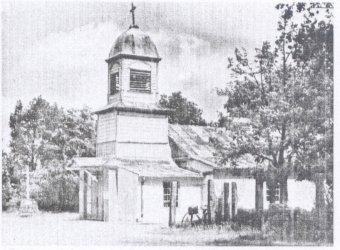
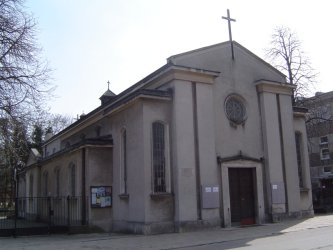
Powazki Military Cemetery In Warsaw - The Insurgents' Cemetery Sections.
Built in 1912 for Russian garrison in Warsaw, the Orthodox cemetery (named 'The Tsar Cemetery') has a long history owing to its role in World War I. Dead soldiers of various armies were buried there. After Poland's regaining the independence in November 1918, the cemetery was run by military priesthood that renamed it to Powazki Military Cemetery. To adjust the cemetery to the new formula, it was rearranged and modernized including an expansion of the area to 24,5 hectares and paving the main alley. The wooden Orthodox Church was transformed into St. Jozefat Kuncewicz Catholic Church.
 |
 |
St. Jozefat Kuncewicz Catholic Church; the former view on the left, on the right-the present state
From the first days of the independence, the Polish authorities and the society had been striving to endow the cemetery the character of central military necropolis. In isolated plots, 2500 soldiers were buried after having been exhumed form the battlefields of Polish - Soviet War 1919 - 1920, in other graves many soldiers of various Polish military formations from World War I (Polish Legions, Polish Military Organisation, 'Dowborczycy' and 'Hallerczycy') were buried.
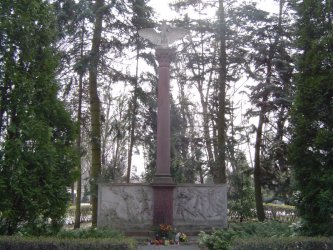 |
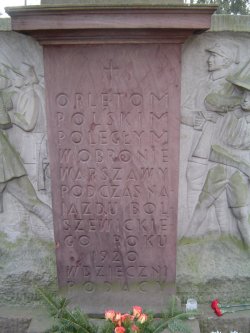 |
Graves of soldiers killed in the 1920 war
The C - 13 section was treated with special reverence where the January Uprising (1863-64) soldiers' ashes were buried and the veterans of the 1863 uprising were continued to be buried. All of the monuments and plaques reminded the struggles for independence and the highest price that had to be paid.
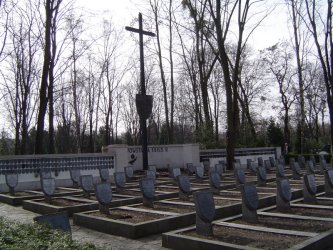 |
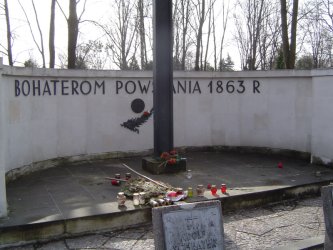 |
Graves of soldiers and veterans fallen in January Uprising 1863
Visited by citizens of the capital and people coming from all over the country, the Cemetery became an outstandingly important and commonly honoured place, primarily among young people who started to participate in great numbers in the ceremonies of patriotic anniversaries, manifestations to the glory of the Dead Soldiers, funerals of notables absorbing the models for responsible civic conduct from the shrines of the national heroes.
After German invasion in 1939, the Military Cemetery started to fill up with victims killed in the September '39 Defense of Warsaw. Over the 5-year-long German occupation, the Cemetery was still administered by Polish church authorities, however, due to the commonly ruling terror, very few funerals were taking place there.
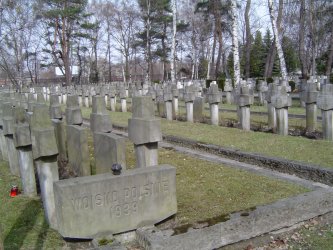
Graves of Polish soldiers killed in September 1939
Therefore, it is noteworthy that three dead soldiers of Armia Krajowa (AK - Polish Home Army)) - Szere Szeregi (Underground Scouting) were buried there after they had been killed in fight against the occupying Germans. The first one was Jan Bytnar a famous young soldier (code name 'Rudy') rescued from prison by his friends in the famous operation near the Arsenal on 26th March 1943 yet died from wounds received during the cruel Gestapo investigation. The organisers of the funeral, Tadeusz Zawadzki ('Zoska') and Jan Wuttke ('Czarny Jas') the funeral, supported by priesthood section of AK were given permission to bury their friend under a false name of 'Jan Domanski' on 3rd April 1943, in plot A - 20.
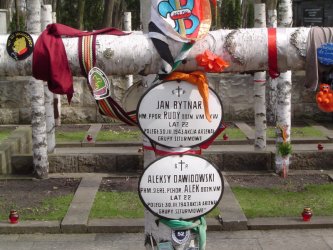
Jan Bytnar's grave (present view)
The second buried there, on 8th June 1943, was sergeant cadet Tadeusz Mirowski - 'Oracz'.
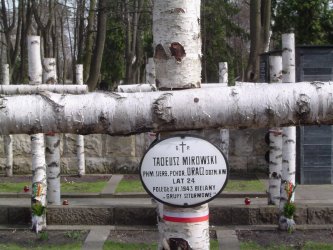
Tadeusz Mirowski's grave (present view)
Before long, the third of the soldiers Tadeusz Zawadzki, 'Zoska' - the commander of Warsaw 'Grupy Szturmowe' (Assault Groups) was killed on 20th August 1943, in the attack to Grenzschutz post in Sieczychy.
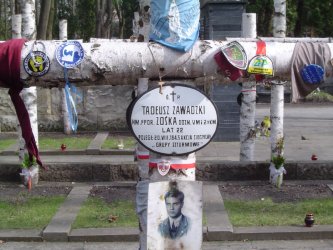
Tadeusz Zawadzki's grave (present view)
To commemorate the daed commander, on 1st September 1943, the Polish Home Army Sabotage Section created a new battalion named 'Zośka' ). Following the testimony of its soldiers: "already before the Warsaw Uprising almost the entire cemetery section, empty by then, was filed with birch-tree crosses".
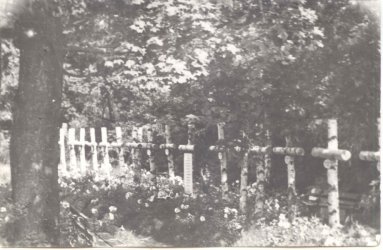
'Zoska' cemetery section in 1945
Today, this place makes a particularly outstanding view, not leaving the passers-by indifferent.
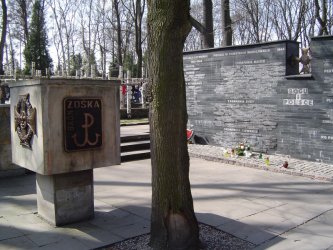 |
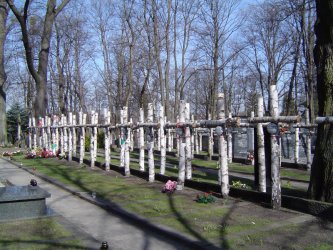 |
'Zoska' battalion cemetery section (present view)
Burying the deads under conspiracy, especially in a military cemetery, was very risky and dangerous. It required huge efforts from organizers. The assistance and help from hospitals, funeral houses, officials preparing 'false' death certificates and gravediggers was invaluable. Over time, special unts were created to deal with such funerals, and the operations of conspiracy graves in the Military Cemetery make up history of outstanding deeds and must be given the highest honour.
After the failure of the Warsaw Uprising, in October 1944, when civilians were expelled from the city and soldiers taken to war camps, in the burnt and totally destroyed city, there was no more life. Among debris, in makeshift graves on squares, backyards and streets the bodies of insurgents and civilians had been buried. Many dead bodies were lying on the ground as there had been no time to bury them.
It was not until 17th January 1945, when the Polish and Soviet troops marched into Warsaw. The citizens started to return to the abandoned houses and soldiers, who had not been taken war prisoners and who - despite a formal dissolution of the Home Army (19th January 1945) - continued to operate in conspiracy. A newly formed organization commanded by Leopold Okulicki 'Niedzwiadek' and, after his arrest by the Soviets in March 1945, by colonel Jan Rzepecki 'Prezes', apart from strictly political and military character, was involved in civil works for the benefit of the society.
It had a great influence on the decisions made by colonel Jan Mazurkiewicz 'Radoslaw', the Commander of Central Area DSZ. He and his soldiers had left Częstochowa and lodged in a suburbe of Warsaw in early February 1945. The base of conspiracy was made of former soldiers of - Sabotage Section of AK., mainly those from former battalions AK - 'Zoska' and 'Miotla'.
In early spring 1945, the authorities dependent on pro-communist Lublin Committee, ordered removing all dead bodies from streets, squares and buildings of Warsaw and then bury them in common graves. The most important were the sanitary reasons, but there were also political aspects - the communists wanted to diminish the role Home Army had played during the Warsaw Uprising.
The Commanders of both of groups were given the conspiracy order to look for, find and identify the bodies of the soldiers killed in the Warsaw Uprising and, also, secure them and help the Polish Red Cross with the funerals and bury them in cemeteries if possible. Lieutenant Henryk Kozlowski 'Kmita' from 'Zoska' battalion delegated the supervision over those operations to Bogdan Celinski ' Wiktor'. From 'Miotla' battalion, the second lieutenant 'Anatol' and then lieutenant, Tadeusz Janicki 'Tadeusz Czarny', were delegated the supervision over the exhumation operations.
The most important thing was to find and identify the bodies of soldiers before they were placed common graves in the Old Town, Krasinski Garden and in Czerniakow district, on the bank of the Vistula. A similar operation within the circle of ex -soldiers and families from battalion AK 'Parasol' was initiated by Halina Dunin - Karwicka - Rakoczy, 'Janina'. They were working in five sections in all of the mass exhumation operations in Warsaw, identifying their friends killed in the Uprising.
As a confirmation of the work in conspiracy were the Minutes by Polish Red Cross full of fake data of the exhumation witnesses. The reason was the continuing war against Germany and the attitude of the new authorities fighting with the Home Army and underground organizations. The PCK - Polish Red Cross group cooperating with soldiers of 'Miotla' was run by Anna Pia - Mycielska, also the Home Army soldier, who was signing her proceedings with 'AM' initials starting with 24th March 1945.
Because of haste, deficiencies in volunteers and transport and the difficulties of administration nature, individual funerals were rare. Nevertheless in a spring and summer 1945 it was possible to bury some soldiers - insurgents in the Military Cemetery in Powazki in the sections that had been agreed upon with the parish priest of St Jozefat Church - M. Zemralski with the co-operation of the brigade of the main gravedigger - Jedrzejewski. The special ceremonial funeral was held in late February 1945, when the recently recovered body of captain - scautmaster Andrzej Romocki 'Morro', the commander "Rudy" company within 'Zoska' battalion, was buried.
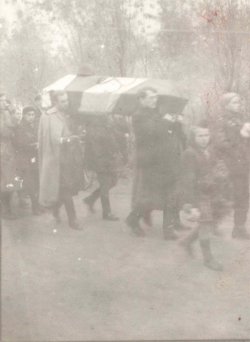
The funeral of Andrzej Romocki 'Morro' in 1945
Some say that colonel 'Radoslaw' was seen among the participants of that funeral. He prized 'Morro' and his deeds a lot.
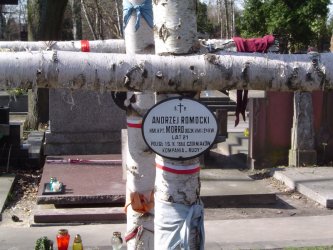
The grave of Andrzej Romocki (present view)
The situation got better when the Liquidation Commision of former Home Army was created in September 1945. Individuals disclosing their identities to the communist authorities managed to work legally (although - as it turned out a little later - it was not safe).
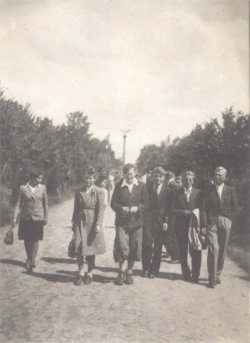
Soldiers from 'Zoska' battalion getting out of Military Cemetery in 1945.
In the background - the monument of 'Orleta Warszawskie 1920' (replaced to B-11 cemetery section after the war)
While concluding an agreement with col. 'Radosław' on 8th September, concerning the underground DSZ Area soldiers' disclosure, communist authorities did not confiscate the funds of the organization and thus, the cash was used for such social causes as: buying plots and sections in the Powązki re-exhumations of soldiers buried in temporary graves, construction of the monument in the AK cemetery military sections - material aid for families of the killed soldiers, including the gen. "Grot" dormitory for insurgent's orphans). It was possible thanks to head of Caritas branch, priest Zygmunt Troszczyński's, donation of the ruins of buildings attached to the parish church in Marymont district.
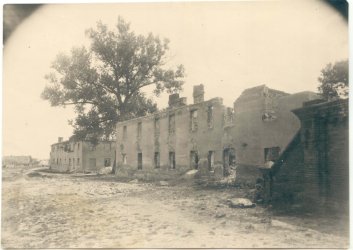
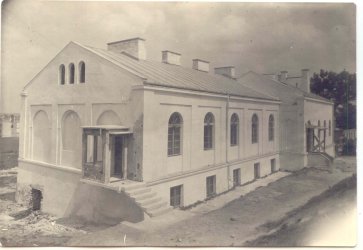
The gen. "Grot" dormitory
In winter 1945, colonel 'Radoslaw' and his group tried to formulate plan of works for the next spring. There were still strong signals indicating a growing hatred from authorities to the soldiers of the former Home Army originating from the anticommunist conspiracy environment. The authorities did not believe the declarations of peaceful cooperation to rebuild and restore the destroyed country. All of combatants' affairs and matters had to be run by newly created Zwiazek Uczestnikow Walki Zbrojnej o Niepodległosc i Demokracje (Association of Combat Participants for Independence and Democracy) which from the very start objected to isolated cemetery plots being formed for 1944 Insurgents.
The exception to this attitude was a permit given agreement to bury exhumated soldiers from battalion 'Kryska', from Czerniakow district to a Military Cemetery in Powazki. Thanks to the efforts by its past commander - light colonel Zygmunt Netzer 'Kryska' and a committee of families of the soldiers, in 1946 the soldiers were buried in D - 2 section (right bottom corner of the cemetery - looking from from Powazkowska Street).
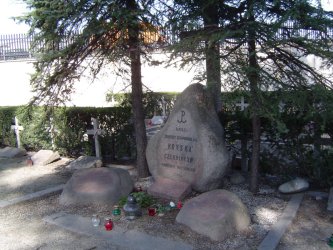
Cemetery section of 'Kryska' Group (present view)
Over the time, all the area was filled with the graves of the insurgents from AK Group 'Lesnik', soldiers from IV Group - Downtown 'Gurt' and AK battalion 'Belt'.
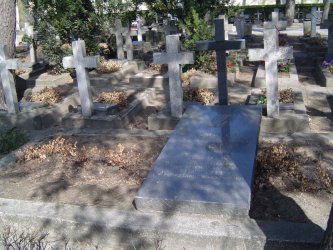 Cemetery section of 'Lesnik' Group (present view) |
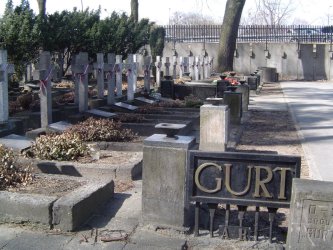 Cemetery section of 'Gurt' Group (present view) |
Cemetery section of 'Belt' Group (present view)
Following the data from Polish Red Cross archive, in the first quarter of 1946, there were 2,368 identified "insurgents" in temporary common graves. The number was obviously underestimated but this category covered only those cases where it was undoubtedly proven that the bodies were of the Uprising soldiers judging by such elements as their documents, cards, bands or clothes).
Earlier, on 25th November 1945, in Wola District a new 1.5 ha 'Warsaw Insurgents Cemetery' was established which could indicate an intention of the authorities to exhume all the bodies from common graves to the new cemetery. Only well organized, swiftly arranged operation was able to stop it.
In 1946, the Powazki Military Cemetery was taken over by military administration, but due to the lack of specific cemetery policies, a lot of cases were able to be arranged according to the AK families committees' plans.
There were 11 committees organized with the participation of 'Radoslaw', who staretd representing them. This gave way to creating a telling symbol appealing to the nation's sentiments, placed in a selected place. Only the Military Cemetery seemed to be the only logical site. This called, however, for the basic condition: cemetery sections with possibly great number of individual, appropriately marked graves making up a dense area in the closest vicinity of the monument evoking the patriotic feelings of all those devoted to the idea of independence.
Despite obstacles piled by the communist authorities and thanks to the obstinacy, courage and sacrifice of the committees and pressure by the society, the plan succeeded. When you look closer at the distribution of Insurgents sections on the outline of the cemetery you will notice that majority of them are surrounding the centrally placed 'Gloria Victis' monument.
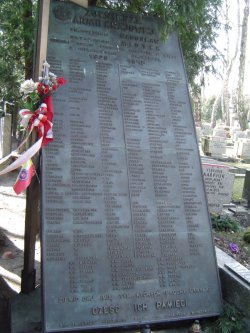 |
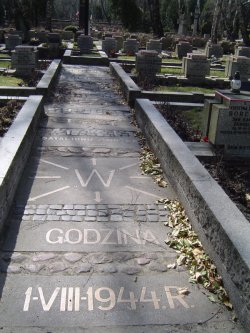 |
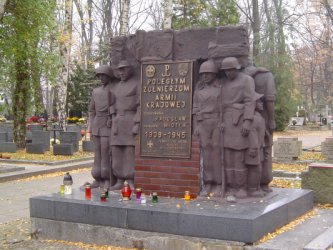 |
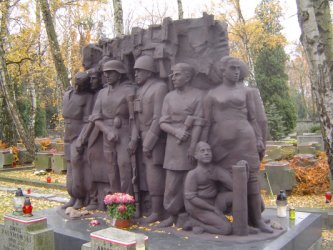 |
Cemetery section of 'Miotla' battalion (present view)
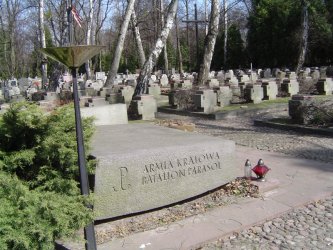 |
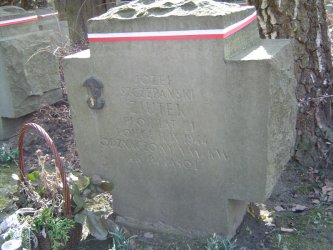 |
Cemetery section of 'Parasol' batallion present view)
Cemetery section of 'Baszta' regiment (present view)
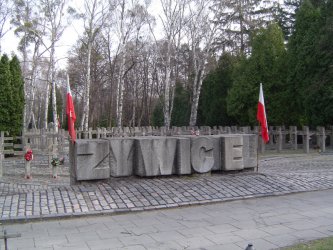 |
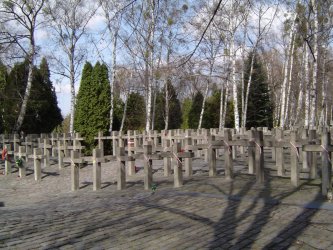 |
'Zywiciel's' Group cemetery section (present view)
The competition for the monument was organized in February 1946. After consideration of some dozen of the projects, the chosen one was a design signed 'Monika'. The author was Helena Klosowicz, former connection and soldier in the Uprising in Old Town. The construction of the monument was vested in the Kozianski Brothers business, who were supervised by the designer herself. It was a tall obelisk made of black marble with an urn on top and pink marble corners. On four granite sides of there were inscriptions made of bronze: 'To soldiers of Home Army who died for freedom - '1939 - 1944' - 'Warsaw Uprising 1. VIII - 2.X.1944' /under the wreath of oak leaves - 'Gloria Victis' / the inscription under war order of Virtuti Militari. A solemn ceremony of the unveiling of 'Gloria Victis' took place on 1st August 1946 by priest canon M. Zemralski on the second anniversary of Warsaw Uprising.
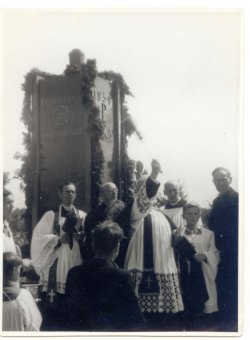 |
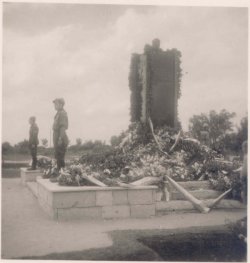 |
Unveiling of the 'Gloria Victis' monument in 1946
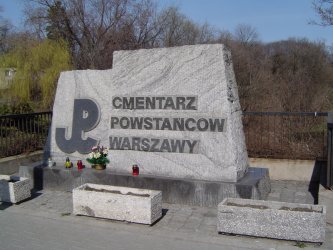 |
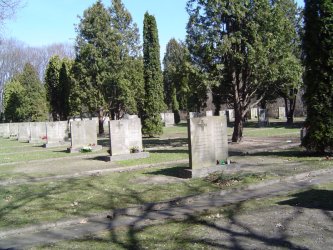 |
Warsaw Insurgents Cemetery in Wola district
In 1973, a great 'The Fallen Unconquerable' monument was unveiled there with the inscription in the bottom part: 'There are remains of over 50 thousand of Polish people killed in 1939 - 1945 fighting the German Nazis for freedom of their Homeland.'
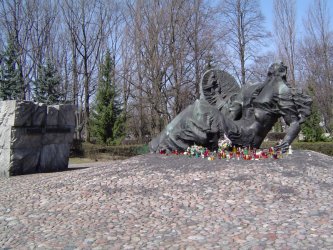 |
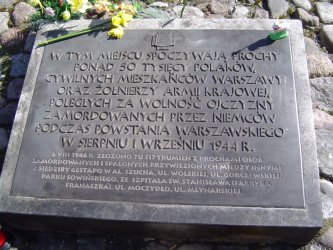 |
'The Fallen - Unconquerable' monument
The time coincidence of both ceremonies by no means diminishes their rank and importance to the dignity of the memory about the victims. The Wola Cemetery and the Insurgents sections in Powazki cemetery are a token of the society remembrance of the people who had died for freedom and independence of Poland. Their martyrdom should never be an object of any wrangle.
The next step of exhumations took place in spring 1947, when the temporary common graves in Krasinski Park had been opened. At this time the Military Cemetery was run by the City Command who made the Zwiazek Uczestnikow Walki Zbrojnej o Niepodległosc i Demokracje to qualify the bodies to the various sections of soldiers.
This gave reasons for many arguments, quarrels or misunderstandings. The permissions for funerals and burying were prepared and issued by a blind war invalid. The management of the Military Cemetery was opposed to burying the Home Army soldiers in that place and directed the bodies to Wola cemetery where they often lay without coffins or any care. In the Powazki cemetery chapel dead bodies were being stored that had not been buried since autumn 1946. There occurred cases of corpse stealing or swapping. . Eventually, on 18th April 1947 the Association stopped all exhumations from Krasiński Garden not giving permits for further burials in the military cemetery. All funerals had to be performed in the Wola cemetery. A letter on the matter by Colonel 'Radosław' to prime minister, remained unanswered.
The funerals of unidentified remains were fairly easy to arrange. They were buried in the extreme sections (C-8, C -0, D-10).
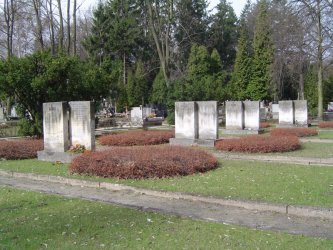 |
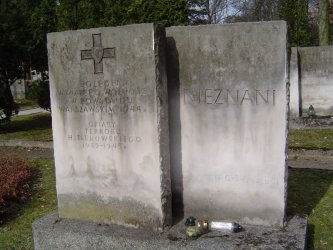 |
Group graves of the unnamed Insurgents
Soldiers from Home Army battalions of: 'Gozdawa' and 'Chrobry II' were buried in B-8 cemetery section.
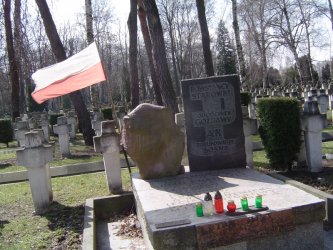 'Gozdawa battalion cemetery section (present view) |
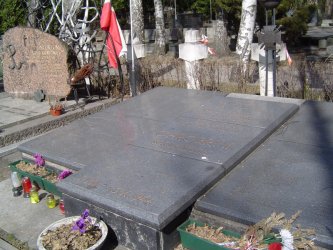 'Chrobry II' Group cemetery section (present view) |
Other sections were filling up gradually, despite protests, bans or suppressions exerted by the authorities which still could not stop the separate Uprising sections being created. This process ended in autumn 1947.